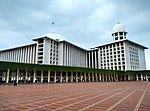Sunan Kudus
Sunan Kudus | |
|---|---|
| Born | 1500 |
| Died | 1550 (aged 50) |
| Employer | Demak Sultanate |
| Organization | Walisongo |
| Title | Waliyyul Ilmi |
Sunan Kudus (born Ja'far Shadiq; 1500-1550), founder of Kudus, is one of the Wali Sanga of Java, Indonesia.
He is said to be at the origin of the wayang golek (traditional Sundanese puppet arts from West Java),[1] and to have founded the mosque (masjid) at Kudus - using the doors from the palace of Majapahit.
History[edit]
He was born Ja'far ash-Shadiq, the son of Sunan Ngudung and Syarifah (sibling of Sunan Bonang), thus the grandson of Sunan Ampel. It is said that he was the son of an Egyptian sultan who had migrated to Java. In the Sultanate of Demak, he was appointed commander of the army. He went forth with Sultan Prawata, battling against Adipati Jipang and Arya Penangsang.[citation needed]
Kudus, islamic hardliner of Arabic origin, was a proponent of a rigorist shariatic sufism. In this he was opposed to moderate islamists also belonging to the Wali Sanga, such as Siti Jenar who proned a more mystical approach of sufism,[2] called pantheist sufism (union of man and God, wujûdiyah, manunggaling kawulo gusti); or Javanese Sunan Kalijaga (or Kalijogo) who wanted to spread islam in Java while respecting Javanese customs and traditions.[3]
Theological dynamics were often influenced and/or interrupted by political interventions from one faction or another[3] - and reciprocally. Thus Kudus supported the prince of Jipang; whereas Sunan Kalijogo supported Sunan Prawoto. So Kudus instigated that the prince of Jipang killed Sunan Prawoto; but the prince of Jipang was subsequently defeated by the founder of the new sultanate of Pajang, Joko Tingkir, and could not claim the throne of Demak.[3]
Sheikh Siti Jenar[3] and his disciples Pangeran (Prince) Jipang and Sunan Panggung (Pengging) were executed upon the order of either Ja’far Sadik or Sunan Kudus, who was at that time at the head of religious affairs in Demak Sultanate.[4]
The sultan of Demak sent Kudus as ambassador to the small kingdom of Pengging, at the foot of Mount Merapi (Central Java), in a attempt to obtain the submission of the reigning prince who was an adept of Sheikh Siti Jenar. Facing obstinate refusals, Kudus also had that prince killed.[5] He is also the main accusator of two other religious masters: Sheikh Jangkung on the pretext that the latter wanted a mosk to be built without having received his permission; and Sheikh Maulana, a disciple of Sunan Gunung Jati whose doctrine diverged from that of Kudus.[5]
Then Kudus also had a tiff with the sultan of Demak about the beginning of Ramadam month. But as he had been defeated, he left Demak for Tajug and transformed that region in an islamic state in 1549.[3]
References[edit]
- ^ "Wali Songo: The Nine Walis". gimonca.com. Retrieved 27 May 2024.
- ^ Ardhana, I Ketut. "Syekh Siti Jenar and Danghyang Nirartha: Historical Relation of Islam and Hindu in Java and Bali". In Sarjana, I Putu; Wibawa, I Putu Sastra (eds.). Tolerance and Pluralism in Southeast Asia (PDF) (International Seminar, October 2, 2018). Denpasar: Unhi Press. pp. 32-38 (see p. 34). ISBN 978-602-52255-7-4.
- ^ a b c d e Nubowo 2023, p. 32.
- ^ Nubowo 2023, p. 31.
- ^ a b Nubowo 2023, p. 32, note 75.
See also[edit]
- Islam in Indonesia
- The spread of Islam in Indonesia (1200 to 1600)
- Ali al-Uraidhi ibn Ja'far al-Sadiq
Bibliography[edit]
- Nubowo, Andar (2023). La genèse d'un "islam du juste milieu" en Indonésie : histoire et portée de l'institutionnalisation d'une notion ambigüe [Genesis of a "golden mean islam" in Indonesia: history and scope of the institutionalisation of an ambiguous notion] (PDF) (phD in History) (in French). École normale supérieure de Lyon. pp. 30–31.
{{cite book}}: CS1 maint: location missing publisher (link) - Sunyoto, Agus (2014). Atlas Wali Songo: Buku Pertama yang Mengungkap Wali Songo Sebagai Fakta Sejarah (6th edition). Depok: Pustaka IIMaN. ISBN 978-602-8648-09-7.
{{cite book}}: CS1 maint: location missing publisher (link)

